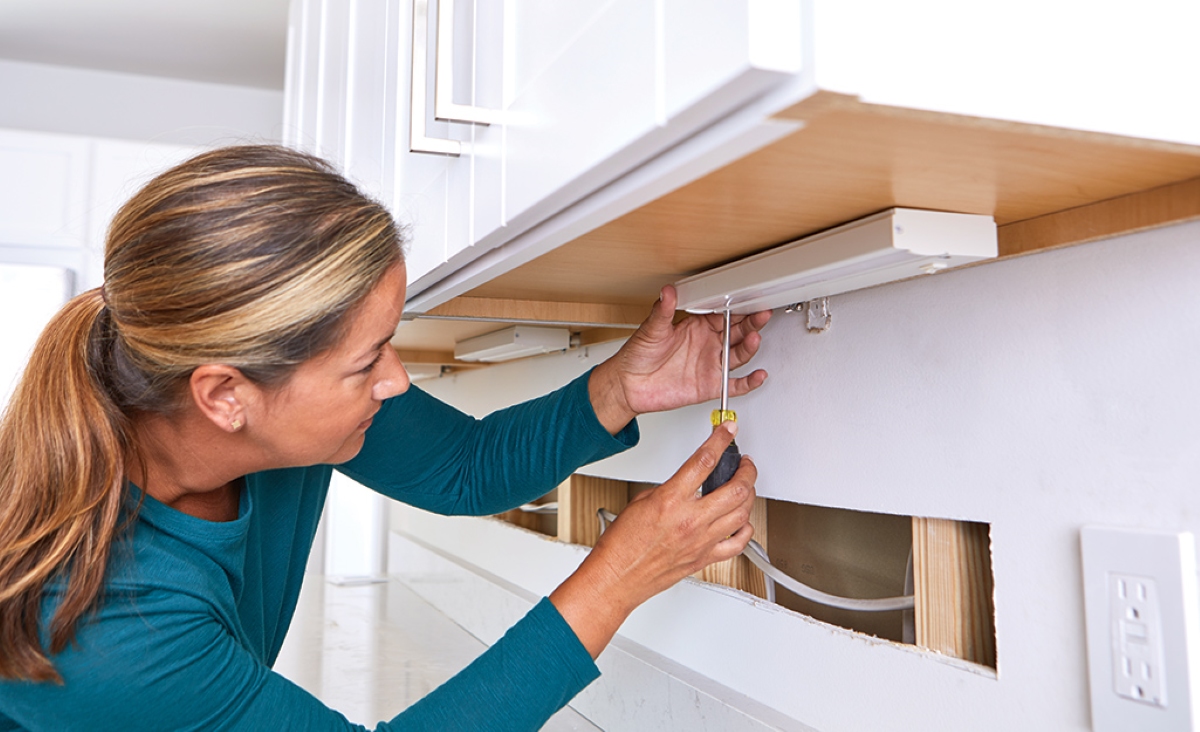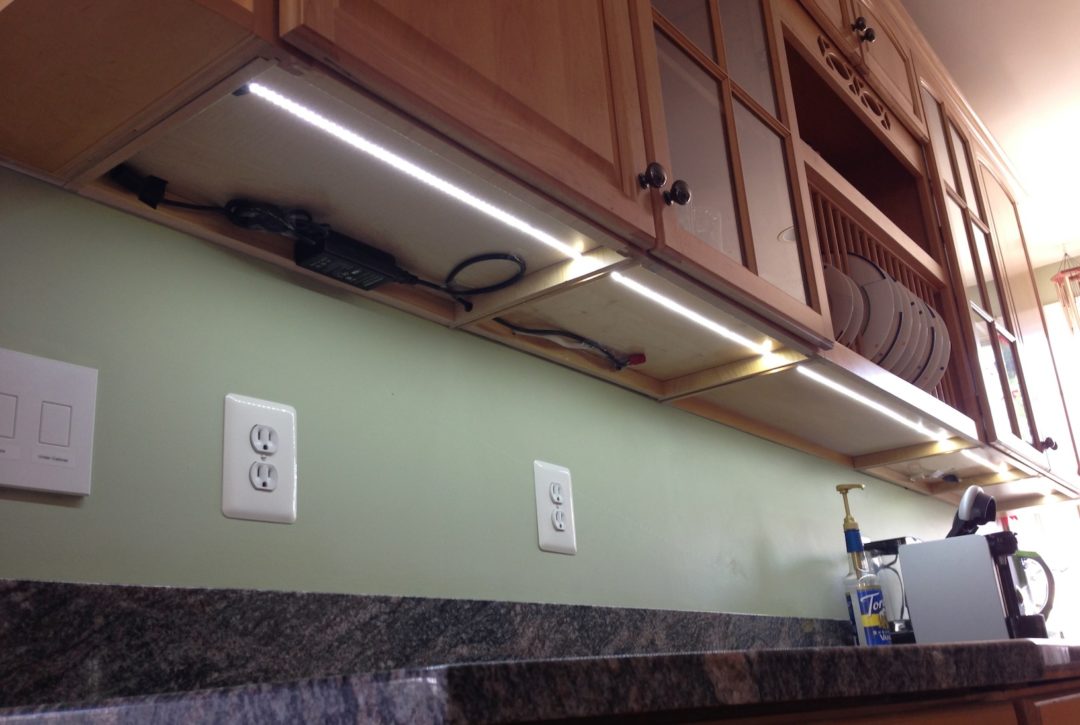Concealing Cords with Existing Features

Sometimes, the most elegant solutions are the simplest. Instead of adding new features to hide your under-cabinet lighting cords, why not leverage what’s already there? Existing architectural elements like baseboards, crown molding, and cabinet door frames offer a discreet and often overlooked way to conceal wires.
Utilizing Molding Channels, How to hide cord for under cabinet light
Molding, especially baseboards and crown molding, often have channels or grooves designed for various purposes. These channels can be a perfect hiding place for your cords.
Think of it like a secret passageway for your wires.
- Baseboards: Many baseboards have a small groove running along their bottom edge. This groove is typically meant for hiding wall-mounted cords, but it can also work for under-cabinet lighting wires.
- Crown Molding: Crown molding, which sits at the junction of the wall and ceiling, can also have hidden channels. These channels are often used for concealing electrical wiring for ceiling fixtures, but they can also accommodate under-cabinet lighting cords.
- Cabinet Door Frames: Cabinet door frames can be a discreet hiding place for cords. Some frames have a small groove along their edges that can be used to run cords, especially if you’re using a plug-in under-cabinet light.
Securing Cords with Clips and Strips
Once you’ve chosen your molding channel, you’ll need to secure the cord within it. This is where wire clips and adhesive strips come in handy.
- Wire Clips: These small plastic clips are designed to hold wires securely in place. They come in various sizes to accommodate different cord thicknesses. You can simply push the clip into the molding channel and then slide the cord through it.
- Adhesive Strips: These strips offer a more permanent solution. They are often made of double-sided adhesive and can be attached to the inside of the molding channel. Simply stick the strip in place and then press the cord against it.
Creative Cord Management Techniques

Sometimes, even with the best planning, those pesky cords can still be a bit of an eyesore. But don’t despair! We’re about to dive into some seriously creative ways to tackle this problem. Think of it as a design challenge, where we use decorative elements to hide those cords and create a more visually appealing space.
Decorative Cord Concealment
Let’s face it, cords don’t exactly scream “chic.” But with a little ingenuity, we can transform them into hidden design elements. Picture frames, wall-mounted shelves, and even strategically placed plants can be our allies in this mission.
Imagine this: you’ve got a beautiful picture frame hanging on the wall, and a cord running down beside it. Instead of letting it dangle freely, we can use a small, inconspicuous channel or groove in the back of the frame to tuck the cord neatly away. This creates a clean and seamless look, making the cord practically disappear.
- Picture Frames: Picture frames with a channel or groove in the back can be used to conceal cords running down the wall.
- Wall-mounted Shelves: Wall-mounted shelves with a small cutout on the back can be used to hide cords running behind them.
- Plants: A strategically placed plant can be used to obscure cords running behind it. You can even use a small plant pot with a hole in the bottom to thread the cord through.
Cord Covers and Sleeves
If you’re not into DIY projects or simply want a quick fix, cord covers and sleeves can be a lifesaver. These come in various colors and materials, allowing you to match them with your existing decor. Think of it as giving your cords a stylish makeover.
- Cord Covers: These are essentially tubes that slip over the cord, concealing it from view. They come in various materials, including plastic, metal, and fabric, and can be found in a variety of colors and patterns.
- Cord Sleeves: These are similar to cord covers but are typically made of a flexible material, such as fabric or vinyl. They can be used to bundle multiple cords together and make them look more organized.
Electrical Solutions for Cordless Lighting: How To Hide Cord For Under Cabinet Light

How to hide cord for under cabinet light – Tired of those pesky cords dangling from your under-cabinet lights? Well, fret no more! We’re about to dive into the world of cordless lighting, where you can ditch the wires and embrace the freedom of a clutter-free kitchen. Think of it as a liberation from the shackles of tangled cords – a kitchen revolution, if you will!
Battery-Operated LED Lights
Let’s start with the classic: battery-operated LED lights. These bad boys are like the superheroes of the lighting world, packing a punch with their long-lasting power and energy-efficient performance. Think of them as the eco-friendly choice for your under-cabinet lighting needs. But, like any superhero, they have their own set of strengths and weaknesses.
- Brightness: Battery-operated LEDs can deliver surprisingly bright illumination, often comparable to their wired counterparts. However, their brightness might be slightly limited, especially for larger spaces or when you need a super-intense light.
- Lifespan: The good news is, battery-operated LEDs have a remarkably long lifespan, with some models boasting up to 50,000 hours of operation. This means you can enjoy years of worry-free lighting before needing to replace the bulbs. But, you’ll need to keep an eye on those batteries – it’s a constant game of charging and replacing.
- Cost: The initial cost of battery-operated LED lights can be a bit higher than wired options, but consider this: you’re saving on electricity costs and avoiding the hassle of running wires. It’s a long-term investment that pays off in the long run.
Wireless Charging Systems
Now, let’s talk about wireless charging systems – the future of cordless lighting! These innovative systems work by using electromagnetic induction to transfer energy wirelessly, eliminating the need for physical wires. Think of it as a futuristic way to power your lights, just like you charge your smartphone. But, as with any new technology, there are pros and cons to consider.
- Brightness: Wireless charging systems are capable of producing bright illumination, comparable to traditional wired lights. They can handle even larger spaces and provide the intense lighting you need for various tasks.
- Lifespan: The lifespan of wireless charging systems depends on the quality of the components and the frequency of use. Generally, they offer a decent lifespan, but it’s essential to choose reputable brands for durability and longevity. You’ll need to ensure your charging pad is in good working order, too.
- Cost: Wireless charging systems can be more expensive than battery-operated LEDs, mainly due to the advanced technology involved. But, consider the convenience and the potential for long-term cost savings on electricity. It’s an investment in convenience and efficiency.
Comparison of Wireless Lighting Solutions
Let’s break down the key differences between these two cordless lighting options to help you make an informed decision.
| Feature | Battery-Operated LED Lights | Wireless Charging Systems |
|---|---|---|
| Power Source | Batteries | Electromagnetic induction |
| Brightness | Good, but may be limited for large spaces | Excellent, comparable to wired lights |
| Lifespan | Very long (up to 50,000 hours), but batteries need replacement | Good, depending on quality and use |
| Cost | Higher initial cost, but lower ongoing costs | Higher initial cost, but potential for long-term savings |
| Installation | Easy, no wiring required | May require a charging pad installation |
Okay, so you wanna hide your under cabinet light cord, right? Like, totally get it. You could try running it along the back of the cabinet and then down the wall, or maybe even use a cord cover to blend it in.
If you’re going for a super cool vibe, check out this article on black and grey bedroom walls – it might give you some ideas on how to make your whole room look super rad. Then, you can just use a matching cord cover and boom, problem solved!
Okay, so you’re trying to hide those pesky cords for your under cabinet lights, right? Totally get it! You can try running them along the back of your cabinets, or maybe even tucking them behind a trim board.
But if you’re looking for a more permanent solution, maybe you should check out these 1 bedroom fort lauderdale apartments – they’re super chic and probably already have some awesome lighting features! Anyway, back to those cords… you could also try using a cord cover to keep things looking clean and organized.
Whatever you do, just make sure those cords aren’t tripping anyone up!